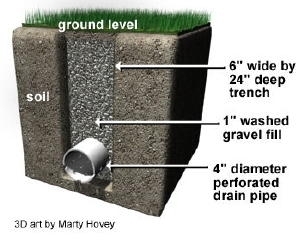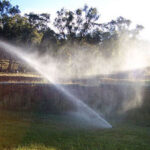If there’s one thing I know about it’s French drains. French drains are also called underground drains and are usually installed for one of two reasons: Reason numbers one is to intercept ground water and to divert it to somewhere else. The other reason is to carry away surface water. All you do-it-yourself, home-fixer-uppers can pull up a chair while we talk drainage and do some bonding at the same time.
According to thisoldhouse.com, the French drain is a time-honored system for eliminating excess water from low points and other areas prone to saturated soil. French drains are quite simple: in essence they are just trenches filled with gravel, with sand on top of that. Often, you’ll see French drains defined to include a drain pipe as well, though the traditional design is simply the gravel-filled trench. The advantages of French drains are low cost and easy installation. In addition, they can be covered over with turf after installation, making them less conspicuous.
In it’s simplest form, a linear French drain is simply a “moat” that protects your yard or house from sub-surface or surface water. You construct it by digging a 6 inch wide trench approximately 24 inches deep (see illustration). If you want to intercept sub-surface water to dry out your yard, you install the trench along the highest part of your property. Extend the trench to the lowest part of your yard. If your intent is to protect your house from water, you construct the trench approximately 4-6 feet away from the foundation. In many cases the trench system is U shaped as it passes around your house.
Askthebuilder.com points out that a 1-percent slope equals a drop of 1 foot over a distance of 100 feet. For shorter distances, the drop can be quite small. For example, a 20-foot run needs a drop of just 0.2 foot (a little more than 2 inches) for a 1-percent grade. Shorter drains may be easy to grade with the help of a good level.
Grading is a critical consideration — you must ensure that enough slope exists for the water to actually flow, and flow in the right direction. It might be adequate to check very short stretches of drain with a level to ensure that a slope exists to carry water in the desired direction. However, you should take whatever measures are necessary, including a survey and grading, if needed, to ensure that you have at least a 0.5 percent slope. A 1 or 2 percent grade is better.
Keep in mind: add gravel to the trench to within a few inches of the surface. Gravel for this use is typically 0.5 to 1 inch in size. On top of the gravel, lay at least 3 or 4 inches of coarse sand. This provides a medium in which turf can grow so that the trench will not be visible. But remember that the sand must be coarse or it won’t allow water to properly drain through.
Turf may be seeded into the sand or simply allowed to grow in from the adjacent stand, if the turf is a spreading type. Or, you can lay sod over the sand. However, if you do this, be sure to wash the soil from the sod roots before laying it so that you don’t contaminate the sand with finer soil.
And by the way, if you think French drains have anything at all to do with France then think again: in fact, they were invented in Concord by Henry French, father of sculptor Daniel Chester French, whom we must flood with congratulations for their effectiveness. According to Concordma.com, Henry French was a judge and farmer, and as the latter a veritable fount of information on drainage. He was a great local source to tap on the subject, one which farmers with wet fields, barns, and roads lapped right up. In fact, his knowledge was so deep and unsinkable, he wrote a lengthy book on the subject, one whose subtitle is so long it takes a moment to fully drink in: Farm Drainage: The Principles, Processes, and Effects of Draining Land with Stones, Wood, Plows, and Open Ditches and Especially with Tiles ( Including Tables of Rain-Fall, Evaporation, Filtration, Excavation, Capacity of Pipes; Cost and Number to the Acres).
I’ve seen long titles on Associated Content (probably from my own stories!)






